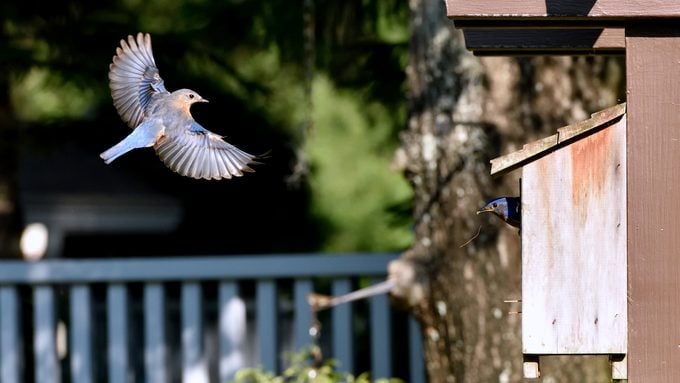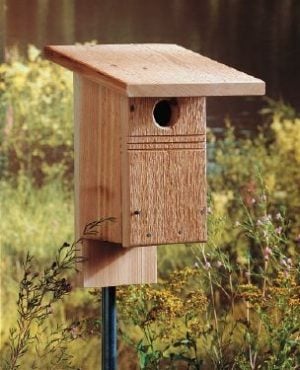https://www.birdsandblooms.com/backyard-projects/diy-birdhouse/diy-birdhouse-bluebirds/Home Backyard Projects DIY Birdhouse
How to Make a DIY Bluebird House
Kirsten SchraderUpdated: Jan. 26, 2022
Every editorial product is independently selected, though we may be compensated or receive an affiliate commission if you buy something through our links. Ratings and prices are accurate and items are in stock as of time of publication.
Want to attract bluebirds to nest in your yard? Make a bluebird box! These DIY bluebird house plans meet the songbirds' specific nesting requirements.
COURTESY TIM LABORDE
Want to do something that’s good for bluebirds—and fun for you? Learn how to build a DIY bluebird house! You’ll be charmed by the brilliant birds’ beauty and their cheerful singing… not to mention
adorable baby bluebirds. Since their diet consists primarily of
insects and grubs, your garden may benefit, too.
In the past, bluebirds relied on woodpeckers and other cavity-dwellers to provide the majority of their nesting places. They’d select abandoned cavities in dead trees or rotten fence posts to raise their families. As development wiped out many of these natural nesting sites, the bluebird population declined dramatically. But nesting boxes have played a vital role in reviving the beloved bluebird. They have fairly specific requirements, so these DIY bluebird house plans are designed to meet their needs.
Here’s more tips on
how to attract bluebirds to your backyard — and if you see a bluebird,
here’s what it means.
Tips for Attracting Bluebirds to Nest Boxes
Bluebirds prefer to nest in open areas with low or sparse ground cover. The
North American Bluebird Society, which provided the plans, says rural areas, cemeteries, golf courses and parkways with minimal human traffic are good places to mount bluebird boxes. Simply drive a 3/4-inch piece of electrical conduit into the ground and attach the house 5 feet above the ground with conduit straps as shown at right. Attach a
predator guard to deter nest raiders.
This bluebird house has a couple of interesting features worth pointing out. It’s assembled with the rough side of the wood facing out so it more closely resembles the birds’ natural nesting sites. And there’s no perch. Notches beneath the entrance hole provide footing for bluebirds, but discourage visits from competing
house sparrows and wrens.
The swing-open side is convenient, also. You can check for nests of unwanted birds (since house sparrows and European starlings are not protected by law, simply remove their nests) and have
easy access for cleaning out the bluebird’s nesting materials after the young have fledged.








